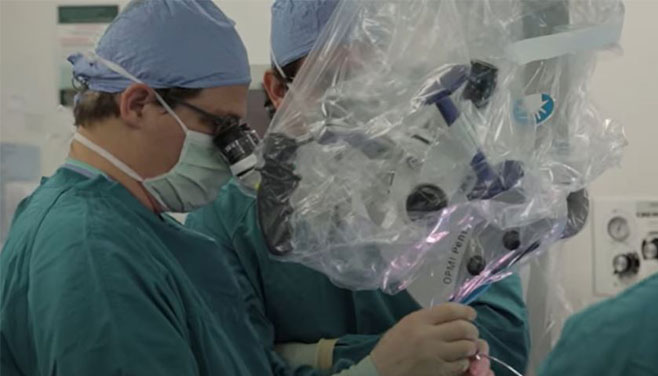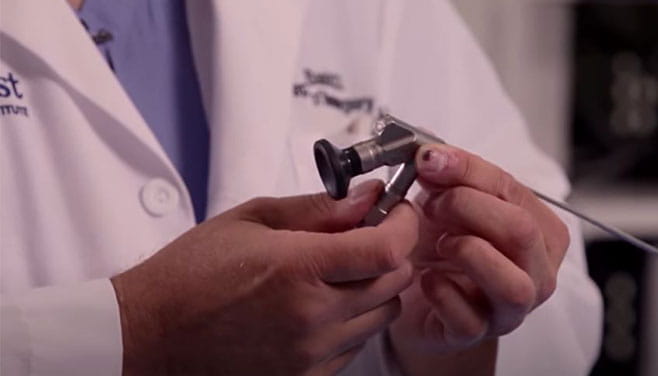Brain Tumor Surgery
U.S. PATIENTS:713.441.8500
INTERNATIONAL PATIENTS:+1.713.441.2340
Find a Brain Tumor Specialist Near You
Houston Methodist’s neurosurgeons are industry leaders in revolutionary surgical and imaging technologies.
Groundbreaking advancements in imaging and surgical technology are making neurosurgery safer and more successful than ever before — and our neurosurgeons are on the leading-edge of these innovations.
Houston Methodist pioneers new approaches to remove brain tumors that once were considered inoperable or high-risk due to their location deep in the brain. Combining decades of neurosurgical experience with our robust multidisciplinary neurology team, our patients receive the most advanced care using the most precise surgical techniques and technologies.
Houston Methodist is one of only a dozen programs in the country with the expertise to use the novel brain surgery system, BrainPath®. Our neurosurgeons train teams around the world on how to use this powerful technology.
BrainPath® Technology and the Six Pillars
BrainPath is used with other minimally invasive techniques to help neurosurgeons maneuver to deep areas of the brain through a dime-sized port. Neuro-navigation and 3D imaging help guide the surgeon through the brain's folds and corridors, navigating the safest route to the tumor.
By following the Six Pillars approach, we offer life-saving surgery to more patients with complex tumors. The steps of the Six Pillars are as follows, with modifications based on the patient’s unique anatomy:
1. Image interpretation and trajectory planning – Using existing brain imaging, we map a path to the tumor that spares normal tissue.
2. Navigation – Like GPS (global positioning system), BrainPath technology guides the neurosurgeon in real time as he or she performs the operation.
3. Optics – High-definition optics provide a clear picture during surgery.
4. Safe access – A slender device called an obturator gently moves healthy tissue aside as it is inserted. The obturator’s external sheath covers a core that is removed once the tip of the device reaches the tumor. The remaining sheath creates a tunnel through which the neurosurgeon can perform the procedure without further disturbing the surrounding brain tissue.
5. Resection – The surgeon carefully removes the tumor through the tunnel, and then removes the sheath.
6. Targeted therapy/neoadjuvant (chemotherapy) – Removing the tumor tissue without damaging it opens the door to possible targeted therapy.
Image-guided Surgery Approaches
New functional MRI technology (fMRI) brain mapping goes further than conventional MRI to show brain activity in response to stimuli. fMRI shows us where critical functions are located in the brain — such as speech, language, sensation, vision and motor functions — so we can create a surgical plan that avoids damaging surrounding tissues.fMRI brain mapping offers a quicker, more accurate and less-invasive alternative to direct electrocortical stimulation (ECS), where electrodes are placed on the surface of the brain to measure and map brain activity.
Virtual-image guidance systems use MRI to provide surgeons an expanded, high-definition view of tiny, yet critical, areas of the brain that are essential to body and cognitive functioning. The system grants surgeons accuracy within 1 mm and can be used to treat multiple tumors, which would have been too dangerous with earlier techniques.
When used in surgical planning, virtual-image guidance helps us find the safest, least invasive path to the tumor during surgery. Neurosurgeons perform procedures in virtual reality first, making the actual operation safer and more precise.
High-frequency ultrasound focuses powerful ultrasound waves precisely to break apart abnormal cells without damaging healthy brain tissue. These focused waves can shatter large tumors into tiny pieces that are easier to remove during surgery. Or, the surgeon can core the tumor like the pulp of an orange, remove the outside and dissect it from surrounding structures more easily.
Minimally Invasive Brain Tumor Surgery
Our neurosurgeons use the least invasive approach possible to result in the best treatment outcome. Minimally invasive surgeries require only small incisions and minimal bone removal. This results in less blood loss, less brain and structural manipulation, less scarring and improved outcomes.
Often, traditional craniotomy can be replaced with a minimally invasive technique. Minimally invasive surgery options include:
- Endonasal endoscopy – The surgeon inserts an endoscope through the nose to reach the pituitary gland and brain without incisions. The endoscope is 1/10 of an inch in diameter and has Blu-ray definition. This is often used to treat hard-to-reach tumors, pituitary tumors and tumors that were previously considered inoperable.
- Minimally invasive endoscopies – The surgeon attaches small instruments to the endoscope to remove diseased tissue. An endoscopic craniotomy uses a tiny endoscope and camera inserted through a small incision in the skull or through the nose without any incision.
- Retrosigmoid (keyhole) surgery – This surgical technique uses a small incision behind the ear to reach tumors at the base of the skull, brainstem and back of the head.
- Supraorbital (eyebrow) approach – This less invasive type of craniotomy uses a small incision in the eyebrow to access tumors in the front of the brain or in the pituitary gland. It is often a better option when tumors are large or are near the optic nerve or major arteries. The incision is virtually undetectable once it heals.
Traditional Brain Surgery
Traditional brain surgery is necessary for certain very complex conditions. With a craniotomy, part of the skull bone is removed so the surgeon can access the brain. This section of skull (called the bone flap) is replaced at the end of surgery.
Types of craniotomies include:
- Stereotactic craniotomy – Surgeons use the virtual imaging guidance system and 3D scans before surgery to plan the safest route to the exact location of the tumor and distinguish it from healthy tissue.
- Craniectomy – Surgeons temporarily remove a section of the skull. It is a life-saving procedure when brain swelling would otherwise be fatal. The bone is stored in a tissue bank and replaced later.
Innovations in Surgical Techniques
By using the latest advances, brain surgery is now more effective and safer than ever.
Innovations in Neurosurgery Research
Endoscopes allow doctors to see in incredible detail. New tools such as neuroendoscopes, robotic arms and special surgical instruments assist with minimally invasive surgeries. Houston Methodist's Dr. David Baskin discusses how we use these tools.


